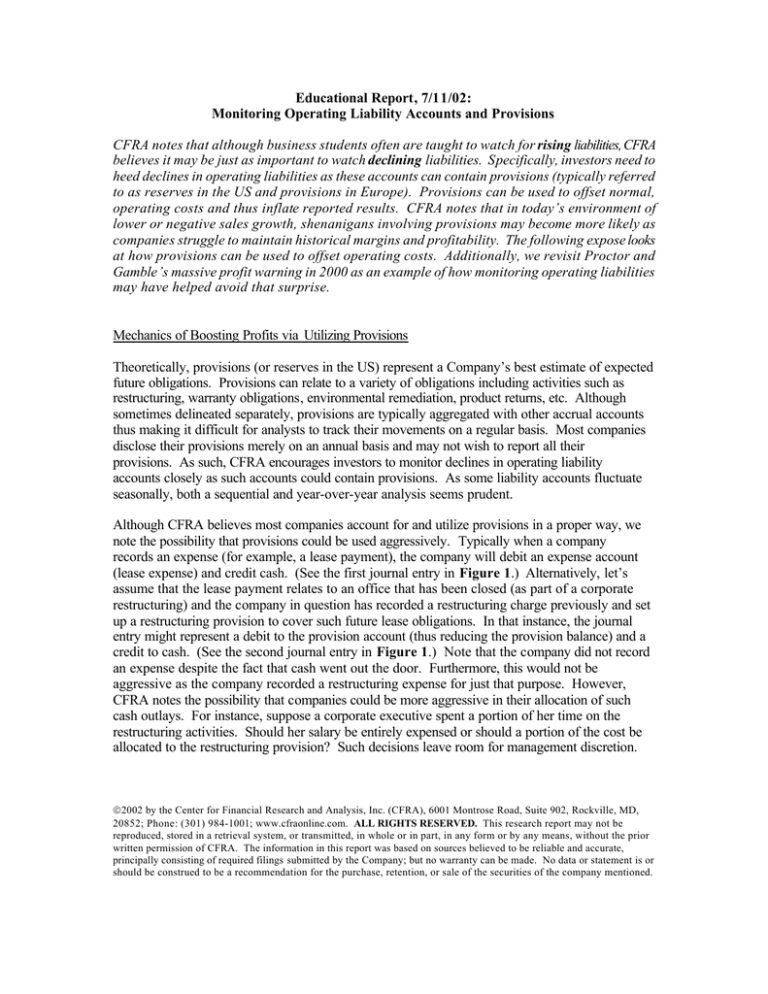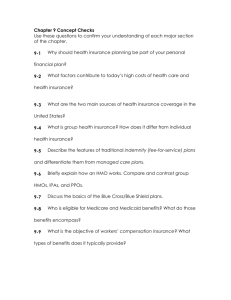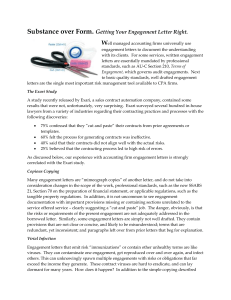
Educational Report, 7/11/02:
Monitoring Operating Liability Accounts and Provisions
CFRA notes that although business students often are taught to watch for rising liabilities, CFRA
believes it may be just as important to watch declining liabilities. Specifically, investors need to
heed declines in operating liabilities as these accounts can contain provisions (typically referred
to as reserves in the US and provisions in Europe). Provisions can be used to offset normal,
operating costs and thus inflate reported results. CFRA notes that in today’s environment of
lower or negative sales growth, shenanigans involving provisions may become more likely as
companies struggle to maintain historical margins and profitability. The following expose looks
at how provisions can be used to offset operating costs. Additionally, we revisit Proctor and
Gamble’s massive profit warning in 2000 as an example of how monitoring operating liabilities
may have helped avoid that surprise.
Mechanics of Boosting Profits via Utilizing Provisions
Theoretically, provisions (or reserves in the US) represent a Company’s best estimate of expected
future obligations. Provisions can relate to a variety of obligations including activities such as
restructuring, warranty obligations, environmental remediation, product returns, etc. Although
sometimes delineated separately, provisions are typically aggregated with other accrual accounts
thus making it difficult for analysts to track their movements on a regular basis. Most companies
disclose their provisions merely on an annual basis and may not wish to report all their
provisions. As such, CFRA encourages investors to monitor declines in operating liability
accounts closely as such accounts could contain provisions. As some liability accounts fluctuate
seasonally, both a sequential and year-over-year analysis seems prudent.
Although CFRA believes most companies account for and utilize provisions in a proper way, we
note the possibility that provisions could be used aggressively. Typically when a company
records an expense (for example, a lease payment), the company will debit an expense account
(lease expense) and credit cash. (See the first journal entry in Figure 1.) Alternatively, let’s
assume that the lease payment relates to an office that has been closed (as part of a corporate
restructuring) and the company in question has recorded a restructuring charge previously and set
up a restructuring provision to cover such future lease obligations. In that instance, the journal
entry might represent a debit to the provision account (thus reducing the provision balance) and a
credit to cash. (See the second journal entry in Figure 1.) Note that the company did not record
an expense despite the fact that cash went out the door. Furthermore, this would not be
aggressive as the company recorded a restructuring expense for just that purpose. However,
CFRA notes the possibility that companies could be more aggressive in their allocation of such
cash outlays. For instance, suppose a corporate executive spent a portion of her time on the
restructuring activities. Should her salary be entirely expensed or should a portion of the cost be
allocated to the restructuring provision? Such decisions leave room for management discretion.
2002 by the Center for Financial Research and Analysis, Inc. (CFRA), 6001 Montrose Road, Suite 902, Rockville, MD,
20852; Phone: (301) 984-1001; www.cfraonline.com. ALL RIGHTS RESERVED. This research report may not be
reproduced, stored in a retrieval system, or transmitted, in whole or in part, in any form or by any means, without the prior
written permission of CFRA. The information in this report was based on sources believed to be reliable and accurate,
principally consisting of required filings submitted by the Company; but no warranty can be made. No data or statement is or
should be construed to be a recommendation for the purchase, retention, or sale of the securities of the company mentioned.
Companies can utilize provisions aggressively by assigning a disproportionate amount of costs to
previously accrued provisions and, as a result, report lower expenses (and higher profits) on their
income statement. Alternatively, companies can act aggressively by releasing (reversing)
provisions into income where the debit is to the provision account and the credit is directly to
income boosting reported profits. (See the third journal entry in Figure 3.) Note in some
circumstances, companies may be acting appropriately in releasing provisions into income (if, for
example, their prior estimates of an expected obligation ended up being too high), however the
impact of such releases should be analysed closely.
In summary, it is often difficult (if not impossible) for an outside analyst to track a company’s
creation and subsequent utilization of provisions. Given that fact, CFRA encourages investors to
monitor operating liability accounts realizing that such accounts likely contain the company’s
provisions. Atypical increases and decreases in operating liabilities should be examined and
considered in the context of the company’s reported business performance. Companies reporting
improved margins or operating performance coupled with declining balances of provisions and/or
operating liabilities should be viewed with a degree of scepticism.
Figure 1: Journal Entries to Record and Expense, Record the Utilization of a Provision, and to
Record the Release (Reversal) of a Provision into Income
Typical Journal Entry to Record a Norman Operating Expense
dr.
cr.
Operating Expense
Cash
Journal Entry to Record a Cost but No Expense by Utilizing Accrued Provisions
dr.
cr.
Provision
Cash
Journal Entry for Aggressive Release (Reversal) of Provision Into Income
dr.
cr.
Provision
Income
Example: Proctor & Gamble Company’s (PG) March 2000 Profits Warning
On March 6, 2000, PG’s stock closed at $86.76, however, on March 10, 2000, PG’s stock closed
at $53.34, a level nearly 39% lower than the closing price just four days prior. The decline in
PG’s stock was the result of a massive profit warning by the Company. CFRA believes, in
hindsight the problems at PG may have been foreseeable based on a number of factors, most
notably a sharp decline in PG’s cash flow from operations driven by a large decline in the
Company’s operating liabilities. Specifically, PG’s operating liabilities, including trade payables
and accrued liabilities, at December 1999 (just prior to the Company’s March 2000 profits
warning) declined year-over-year by 6.9% versus a 6.6% increase in sales. As a percentage of
sales, operating liabilities plunged to 65% of quarterly sales at December 1999 from 74-81% of
sales in each of the prior four quarters. (See Table 1a.)
CFRA notes that when operating liabilities decline, this represents a cash outflow on a
Company’s statement of cash flows. PG’s cash flow statement for the six months ended
December 1999 and 1998 is reproduced below (See Table 1b.) For the six months ended
December 1999, PG’s reported cash flow from operations was $1.5 billion, an amount 24% lower
than the prior year’s figure. The lower cash flow was primarily due to $845 million outflow
attributable to accounts payable and accruals, which contrasts with a $207 million inflow in the
prior year’s period. CFRA believes that the observed outflow related to trade payables and
accruals could have been the result of PG utilizing previously accrued operating provisions. As
such, we note the possibility that the Company may have, in the December 1999 quarter, boosted
reported results by offsetting normal operating costs via the utilization of previously accrued
provisions. CFRA believes that by recognizing the possibility that the December 1999 figures
may have benefited from the observed decline in operating liabilities, investors may have been
less surprised by PG’s subsequent profits warning.
Table 1a: PG’s Operating Liabilities versus Sales, Quarterly Trend
Q2, 12/99
Q1, 9/99
Q4, 6/99
Q3, 3/99
Q2, 12/98
YOY
Change
Sales
10,588
9,919
9,450
9,231
9,934
6.6%
Operating Liabilities*
6,862
7,759
7,611
7,043
7,371
(6.9%)
Op. Liabs. / Sales
65%
78%
81%
76%
74%
`
($ millions, except %)
* Specifically, accounts payable and accrued liabilities.
Table 1b: PG’s Operating Section of Its Statement of Cash Flows, As Reported
($ millions)
Statement of Cash Flows
Six Months, 12/99
Six Months, 12/98
Net Income
2,273
2,309
Depreciation and Amortization
1,081
841
318
58
Change in Accounts Receivables (Debtors)
(548)
(441)
Change in Inventories (Stocks)
(360)
(69)
Accounts Payables and Accruals
(845)
207
Other Operating Assets & Liabilities
(533)
(651)
119
(269)
1,505
1,985
Deferred Income Taxes
Other
Total Operating Activities






